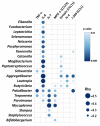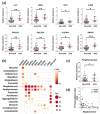Relationship between Respiratory Microbiome and Systemic Inflammatory Markers in COPD: A Pilot Study
- PMID: 39126034
- PMCID: PMC11313397
- DOI: 10.3390/ijms25158467
Relationship between Respiratory Microbiome and Systemic Inflammatory Markers in COPD: A Pilot Study
Abstract
The respiratory microbiome may influence the development and progression of COPD by modulating local immune and inflammatory events. We aimed to investigate whether relative changes in respiratory bacterial abundance are also associated with systemic inflammation, and explore their relationship with the main clinical COPD phenotypes. Multiplex analysis of inflammatory markers and transcript eosinophil-related markers were analyzed on peripheral blood in a cohort of stable COPD patients (n = 72). Respiratory microbiome composition was analyzed by 16S rRNA microbial sequencing on spontaneous sputum. Spearman correlations were applied to test the relationship between the microbiome composition and systemic inflammation. The concentration of the plasma IL-8 showed an inverted correlation with the relative abundance of 17 bacterial genera in the whole COPD cohort. COPD patients categorized as eosinophilic showed positive relationships with blood eosinophil markers and inversely correlated with the degree of airway obstruction and the number of exacerbations during the previous year. COPD patients categorized as frequent exacerbators were enriched with the bacterial genera Pseudomonas which, in turn, was positively associated with the severity of airflow limitation and the prior year's exacerbation history. The associative relationships of the sputum microbiome with the severity of the disease emphasize the relevance of the interaction between the respiratory microbiota and systemic inflammation.
Keywords: COPD; eosinophils; frequent exacerbators; respiratory microbiome; systemic inflammation.
Conflict of interest statement
The authors declare no conflicts of interest.
Figures





References
-
- Ramsheh M.Y., Haldar K., Esteve-Codina A., Purser L.F., Richardson M., Müller-Quernheim J., Greulich T., Nowinski A., Barta I., Stendardo M., et al. Lung microbiome composition and bronchial epithelial gene expression in patients with COPD versus healthy individuals: A bacterial 16S rRNA gene sequencing and host transcriptomic analysis. Lancet Microbe. 2021;2:e300–e310. doi: 10.1016/S2666-5247(21)00035-5. - DOI - PubMed
MeSH terms
Substances
Grants and funding
- CB06/06/0043 and CB06/06/1097/Centro de Investigación Biomédica en Red de Enfermedades Respiratorias
- PI18/00934 and PI21/00785/Fondo de Investigación Sanitaria, Instituto de Salud Carlos III, co-funded by the European Un-ion
- SAF2014-54371/Spanish Ministry of Economy and Competitivity, co-funded by the European Union
- 2017SGR442 and 2021SGR-00100/Agència de Gestió d'Ajuts Universitaris i de Recerca
- 2015 and 2019/Sociedad Española de Neumología y Cirugía Torácica
LinkOut - more resources
Full Text Sources
Medical

